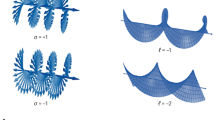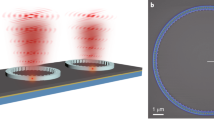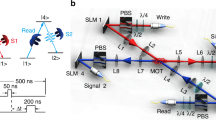Abstract
The orbital angular momentum (OAM) of light, associated with a helical structure of the wavefunction, has great potential in quantum photonics, as it allows a higher dimensional quantum space to be attached to each photon1,2. Hitherto, however, the use of OAM has been hindered by difficulties in its manipulation. Here, by making use of the recently demonstrated spin-OAM information transfer tools3,4, we report the first observation of the Hong–Ou–Mandel coalescence5 of two incoming photons having non-zero OAM into the same outgoing mode of a beamsplitter. The coalescence can be switched on and off by varying the input OAM state of the photons. Such an effect has then been used to carry out the 1 → 2 universal optimal quantum cloning of OAM-encoded qubits6,7,8, using the symmetrization technique already developed for polarization9,10. These results are shown to be scalable to quantum spaces of arbitrary dimensions, even combining different degrees of freedom of the photons.
This is a preview of subscription content, access via your institution
Access options
Subscribe to this journal
Receive 12 print issues and online access
$209.00 per year
only $17.42 per issue
Buy this article
- Purchase on Springer Link
- Instant access to full article PDF
Prices may be subject to local taxes which are calculated during checkout



Similar content being viewed by others
References
Molina-Terriza, G., Torres, J. P. & Torner, L. Twisted photons. Nature Phys. 3, 305–310 (2007).
Franke-Arnold, S., Allen, L. & Padgett, M. Advances in optical angular momentum. Laser Photon. 2, 299–313 (2008).
Marrucci, L., Manzo, C. & Paparo, D. Optical spin-to-orbital angular momentum conversion in inhomogeneous anisotropic media. Phys. Rev. Lett. 96, 163905 (2006).
Nagali, E. et al. Quantum information transfer from spin to orbital angular momentum of photons. Phys. Rev. Lett. 103, 013601 (2009).
Hong, C. K., Ou, Z. Y. & Mandel, L. Measurement of subpicosecond time intervals between two photons by interference. Phys. Rev. Lett. 59, 2044 (1987).
Lamas-Linares, A., Simon, C., Howell, J. C. & Bouwmeester, D. Experimental quantum cloning of single photons. Science 296, 712–714 (2002).
De Martini, F., Buzek, V., Sciarrino, F. & Sias, C. Experimental realization of the quantum universal NOT gate. Nature 419, 815–818 (2002).
Scarani, V., Iblisdir, S. & Gisin, N. Quantum cloning. Rev. Mod. Phys. 77, 1225–1256 (2005).
Ricci, M., Sciarrino, F., Sias, C. & De Martini, F. Teleportation scheme implementing the Universal Optimal Quantum Cloning Machine and the Universal NOT gate. Phys. Rev. Lett. 92, 047901 (2004).
Irvine, W. T. M., Lamas-Linares, A., de Dood, M. J. A. & Bouwmeester, D. Optimal quantum cloning on a beamsplitter. Phys. Rev. Lett. 92, 047902 (2004).
Cerf, N. J., Bourennane, M., Karlsson, A. & Gisin, N. Security of quantum key distribution using d-level systems. Phys. Rev. Lett. 88, 127902 (2002).
Barbieri, M., De Martini, F., Mataloni, P., Vallone, G. & Cabello, A. Enhancing the violation of the Einstein-Podolosky–Rosen local realism by quantum hyperentanglement. Phys. Rev. Lett. 96, 163905 (2006).
Barreiro, J. T., Langford, N. K., Peters, N. A. & Kwiat, P. G. Generation of hyperentangled photons pairs. Phys. Rev. Lett. 95, 260501 (2005).
Barreiro, J. T., Wei, T. C. & Kwiat, P. G. Beating the channel capacity limit for linear photonic superdense coding. Nature Phys. 4, 282–286 (2008).
Aolita, L. & Walborn, S. P. Quantum communication without alignment using multiple-qubit single-photon states. Phys. Rev. Lett. 98, 100501 (2007).
Gatti, A., Brambilla, E., Lugiato, L. A. & Kolobov, M. I. Quantum entangled images. Phys. Rev. Lett. 83, 1763 (1999).
Mair, A., Vaziri, A., Weihs, G. & Zeilinger, A. Entanglement of the orbital angular momentum states of photons. Nature 412, 313–316 (2001).
Vaziri, A., Pan, J. W., Jennewein, T., Weihs, G. & Zeilinger, A. Concentration of higher dimensional entanglement: qutrits of photon orbital angular momentum. Phys. Rev. Lett. 91, 227902 (2003).
Langford, N. K. et al. Measuring entangled qutrits and their use for quantum bit commitment. Phys. Rev. Lett. 93, 053601 (2004).
Bouwmeester, D. et al. Experimental quantum teleportation. Nature 390, 575–579 (1997).
Boschi, D., Branca, S., De Martini, F., Hardy, L. & Popescu, S. Experimental realization of teleporting an unknown pure quantum state via dual classical and Einstein–Podolsky–Rosen channels. Phys. Rev. Lett. 80, 1121 (1998).
Kok, P. et al. Linear optical quantum computing with photonic qubits. Rev. Mod. Phys. 79, 135–174 (2007).
Specht, H. P. et al. Phase shaping of single-photon wave packets. Nature Photon., 3, 469–472 (2009).
Wootters, W. K. & Zurek, W. H. A single quantum cannot be cloned. Nature 299, 802–803 (1982).
Gisin, N., Ribordy, G., Tittel, W. & Zbinden, H. Quantum cryptography. Rev. Mod. Phys. 74, 145–195 (2002).
Ricci, M. et al. Separating the classical and quantum information via quantum cloning. Phys. Rev. Lett. 95, 090504 (2005).
Sciarrino, F., Sias, C., Ricci, M. & De Martini, F. Realization of universal optimal quantum machines by projective operators and stochastic maps. Phys. Rev. A 70, 052305 (2004).
Fiurasek, J. Optimal probabilistic cloning and purification of quantum states. Phys. Rev. A 70, 032308 (2004).
Padgett, M. J. & Courtial, J. Poincaré-sphere equivalent for light beams containing orbital angular momentum. Opt. Lett. 24, 430–432 (1999).
Navez, P. & Cerf, N. J. Cloning a real d-dimensional quantum state on the edge of the no-signaling condition. Phys. Rev. A, 68, 032313 (2003).
Author information
Authors and Affiliations
Contributions
E.N., L.S., F.S., F.D.M., L.M. and E.S. conceived and designed the experiments. E.N., L.S. and F.S. performed the experiments. E.N., L.S. and F.S. analysed the data. L.M., B.P., E.K. and E.S. contributed materials. All authors contributed to the writing of the paper.
Corresponding authors
Rights and permissions
About this article
Cite this article
Nagali, E., Sansoni, L., Sciarrino, F. et al. Optimal quantum cloning of orbital angular momentum photon qubits through Hong–Ou–Mandel coalescence. Nature Photon 3, 720–723 (2009). https://doi.org/10.1038/nphoton.2009.214
Received:
Accepted:
Published:
Issue Date:
DOI: https://doi.org/10.1038/nphoton.2009.214
This article is cited by
-
Intense vortical-field generation using coherent superposition of multiple vortex beams
Scientific Reports (2023)
-
Quantum microscopy based on Hong–Ou–Mandel interference
Nature Photonics (2022)
-
Naturally occurring van der Waals heterostructure lengenbachite with strong in-plane structural and optical anisotropy
npj 2D Materials and Applications (2021)
-
Experimental demonstration of entanglement-enabled universal quantum cloning in a circuit
npj Quantum Information (2021)
-
Tripartite orbital angular momentum quantum information and non-Kolmogorov turbulent atmosphere
Quantum Information Processing (2021)



